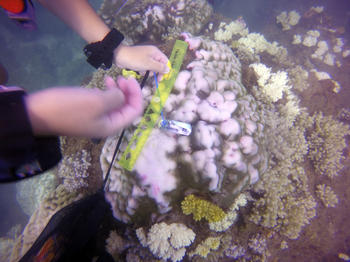Korallenbleiche im Indik durch El Niño’s/La Niña’s Vielfalt
News vom 29.05.2017
Episodisch auftretende Hitzewellen in den tropischen Ozeanen sind oft assoziiert mit dem Klimaphänomen El Niño-Suedliche Oszillation oder kurz ENSO. Diese Hitzewellen führen oft zum massenhaften Ausbleichen der Korallen infolge zu hoher Wassertemperaturen. Zwischen 2014 und 2016 hat eines der stärksten El Niño events aller Zeiten, der sogenannte Godzilla-El Niño, schwere Schäden verursacht in Indo-Pazifischen Korallenriffen. Auch der tropische südöstliche Indische Ozean unweit der Australischen und Indonesischen Küste war von der Korallenbleiche in 2016 stark betroffen. Wenige Jahre zuvor (2011-2013) waren nur die subtropischen Riffe vor der West-Australischen Küste südlich des Wendekreises von starker Korallenbleiche im Zuge eines starken La Niña betroffen während die tropischen Riffe keinerlei Schäden aufwiesen. Daraus ergab sich die Frage was die unterschiedliche Reaktion der Korallen entlang der viele Tausende Kilometer langen Australischen Küste verursacht.
Ein internationals Forscherteam aus Australian, China und Deutschland hat nun herausgefunden dass der Typus der El Niño-Suedlichen Oszillation, also der geograpische Mittelpunkt und die Intensität eines jeden El Niño oder La Niña Ereignisses, fuer das assymetrische Auftreten von Korallenbleiche im südöstlichen Indische Ozean verantwortlich ist. Die Forscher bezeichnen dieses Phännomen als entgegengesetzte Polarität von ENSO. El Niño beeinflusst demnach nur die tropischen Riffe, waehrend La Niña nur die subtropischen Riffe erreicht. Jedoch gleicht kein El Niño oder La Niña dem anderen, sodass vor allem die sehr starken El Niño’s mit ihrem Zentrum im östlichen Pazifik (wie z. B. in 1997/98, 2015/16) zu anomalen Wassertemperaturen und Korallenbleiche in den Tropen des Ostindik führt. Zudem schwächen solche El Niño’s den Australischen Monsun welcher normal für Abkühlung sorgen würde. Für La Niña sind es vor allem Jahre in denen der zentrale Pazifik starke Änderungen aufzeigt (z.B. 1998/19992010/11, 2011/12) die mit erhöhten Temperaturen im westlichen Pazifik einhergehen welche durch Ozeanströmungen in die Subtropen transportiert werden.
Es wird angenommen dass die Stärke von extremen El Niño and La Niña Ereignissen im Zuge fortschreitender Klimaerwärmung zunehmen soll welches auch zur erhöhten Frequenz von Korallenbleiche in tropischen und subtropischen Riffen führen kann. Dabei wird es von entscheidender Bedeutung sein welcher ENSO Typus mit den jeweiligen regionalen Klimaveränderungen wetteifern wird. Diese Interaktion wird ausschlaggebend sein ob extreme Korallenbleiche im südöstlichen Indik in Zukunft häufiger auftreten wird. Das bessere Verständnis dieser regional unterschiedlichen Prozesse hat bereits erfolgreich zur genaueren saisonalen Prognose der 2016 Korallenbleiche im Südostindik gefuehrt sodass zu hoffen bleibt dass in Zukunft ein Frühwarnsystem die nötigen Massnahmen zur Milderung der Auswirkungen auf Natur und Mensch in Gang setzen wird.
Coral bleaching comes with different El Niño/La Niña flavours
Episodic warm sea surface temperature extremes, termed marine heatwaves, which are often associated with the most powerful climate phenomenon– El Niño-Southern Oscillation (ENSO), are among the most important environmental pressures that threaten the sustainability of coral reefs. A large number of the world’s coral reefs were recently influenced by one of the most severe El Niño events on record that lasted from early-2014 to mid-2016, dubbed the Godzilla-El Niño, causing severe coral bleaching worldwide, including in regions previously considered resilient to these effects, such as the tropical reefs in the southeast Indian Ocean (SEIO). However, severe coral bleaching and mortality was also observed at subtropical reefs between 2011 and 2013 in the wake of a very strong La Niña event, the opposite phase of El Niño, which did not affect the tropical reefs at all. The question arose why tropical and subtropical reefs along thousands of kilometers coast line in the southeastern Indian Ocean reacted so differently to these ENSO events.
An international team of scientists from Australia, China and Germany has now discovered that different types or flavours of ENSO have caused the spatial contrast of coral bleaching impacts in the southeastern Indian Ocean. Coral bleaching in the tropical reefs occur more likely during eastern Pacific El Niño events, that is when the maximum warming in the Pacific is observed in the far East Pacific (as in 1997/98, 2015/16), driven by enhanced solar radiation and weaker monsoon on the Indian Ocean side. The subtropical reefs experience bleaching during central Pacific La Niña, that is when a strong ocean surface temperature gradient between cold central and warm western Pacific persists. The accumulated heat in the western Pacific is subsequently transmitted to the subtropical reefs via horizontal wave transport along the West Australian coast reinforced by local Indian Ocean winds. Intraseasonal variability of the climate system, such as the Madden-Julian Oscillation (MJO), also influences the peak amplitudes of the marine heatwaves.
In response to increasing greenhouse gases, extreme El Niño and La Niña events are projected to increase. Our work shows that under the influence of different flavours of ENSO, and modified by Indian Ocean and decadal climate modes (like IOD, MJO, IPO) and local air-sea interactions, the coral bleaching potentials vary across the SEIO, and may occur more frequently in a warming world. Improved understanding of ENSO-induced variabilities, such as marine heatwaves, based on the current research and their predictions can allow for earlier warnings of coral bleaching and to implement ways to mitigate local-scale stress from human-related activities at severely impacted sites. The 2016 heatwave and bleaching was already successfully predicted one season ahead, adding hope to develop better mitigation strategies to better prepare for marine heatwaves.
Read more:
Kontakt
Dr. Jens Zinke
FR Paläontologie
AG Geobiologie und Anthropozänforschung
Malteserstrasse 74-100, Haus C, 105,
12249 Berlin, Germany
jzinke@zedat.fu-berlin.de
+4930 838 61034
